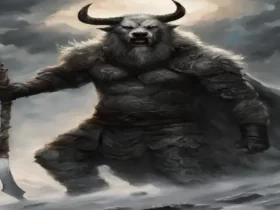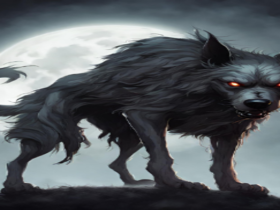While Arawn is often classified as a pagan god, he does not occupy a central position among the primary deities in Celtic mythology. According to Welsh folklore, he served as a king appointed to govern Annwn, one of the many realms within the Otherworld. Described as fair and impartial, Arawn administered punishment to those who dared challenge his authority. Despite the enigmatic nature of Arawn’s past, the beliefs of the people, particularly those in Cardigan, have eternally memorialized his existence among the souls who held faith in him.

Characteristics
Proficient in the art of altering his form, he is frequently depicted as adept at shapeshifting to mirror Pwyll. As a hunter, he takes pleasure in riding a black horse and directing his white hounds with distinctive red ears, commonly referred to as the Hounds of Annwn. His authority and regal stature are symbolized by a golden torc, while his hair is described as a mix of grey and dark tones.
Also Read: Hiisi (Finnish Mythology): Evolving Role From Gods to Goblins
Absolute And Uncontrolled Powers Of Arawn Within Its Own Sphere

As the overseer of his realm, Arawn is esteemed as a just and equitable ruler, known for embodying qualities such as honor, duty, war, terror, hunting, and tradition. In his role as the ruler of Annwn, he earned titles such as the Provider, the Virtuous, and the Guardian of the Lost Souls. However, his connection with death often leads to him being perceived as malevolent. The spread of Christianity across the British Isles contributed to the demonization of Arawn, associating him with death and depicting Annwn as a place where souls were pursued, with him becoming the lord of the damned in that realm. Additionally, his hound companions became linked with the concept of hellhounds.
Arawn & The Welsh Mythology

Arawn holds the designation of the Celtic deity associated with death, war, revenge, and terror within Welsh mythology. He stands as the supreme ruler of the spiritual realm of Annwn, prominently featured in the first branch of Welsh mythology and indirectly referenced in the fourth.
In subsequent traditions, the title of the king of Annwn shifted predominantly to the Welsh psychopomp, Gwyn ap Nudd. Nevertheless, Arawn’s legacy endures through a traditional saying preserved in an ancient Cardigan folktale:
(Welsh): “Hir yw’r dydd a hir yw’r nos, a hir yw aros Arawn.”
(English translation): “The day is long, and the night is long, and the waiting of Arawn is long.”
The Four Branches & Arawn Connection
In the initial segment of the Mabinogi known as the First Branch, Pwyll inadvertently enters the realm of Annwn, where he encounters white hounds with red ears devouring a stag. Acting impulsively, Pwyll drives the hounds away, only to discover later that they belonged to Arawn, the ruler of Annwn. To atone for this mistake, Arawn proposes that Pwyll exchanges places with him for a year and a day, challenging him to defeat Hafgan, Arawn’s adversary—an undertaking Arawn himself has struggled to accomplish. During this period, Arawn assumes Pwyll’s role as the lord of Dyfed. Remarkably, despite the unconventional arrangement, Arawn and Pwyll forge a strong friendship, as Pwyll, while in Arawn’s guise, refrains from engaging in any romantic involvement with Arawn’s wife.
Must Read: Ah Puch (Mayan God Of Death): 13 Terrifying Facts
The enduring friendship between the two realms persists long after the passing of Pwyll. In the fourth branch, Pryderi, Pwyll’s son and the ruler of Dyfed, receives a gift of mystical pigs from Arawn. Unfortunately, these extraordinary pigs are later stolen by Gwydion fab Don, a cunning magician and trickster from Venedotia. Gwydion, assuming the guise of a bard, requests the pigs as a reward for his poems and music, despite Pryderi’s assertion that he is bound by a pact with Arawn, making it impossible for him to part with the pigs. Gwydion manipulates Pryderi into trading the pigs, exploiting the loophole allowed in the agreement with Arawn. This deceitful exchange ultimately leads to Pryderi’s invasion of Gwynedd. In the ensuing conflict, Gwydion engages Pryderi in single combat, resulting in Pryderi’s demise.
A conspicuous absence of Arawn is noted in the Second through Fourth branches of the Mabinogi. Some scholars posit that this omission stems from gaps in the original text and argue that Arawn, along with the events recounted in the First Branch, directly contributes to the birth of Pwyll’s son, Pryderi. The rationale behind the absence of the birth story in the original text is attributed to the fact that, although a significant portion of the Mabinogi delves into the mystical Otherworld of Annwn, this theme is not referenced in the subsequent branches. However, opposing views exist among scholars who refute this notion. They argue that certain contemporary translations introduce inconsistencies into the narrative and deviate from the foundational Llyfr Gwyn, the source text from which the Mabinogi was translated.
Though Arawn plays a crucial role in the initial section of the Mabinogi known as the First Branch, his character appears to serve more as an enhancer of the background narrative for Pwyll (and possibly Pryderi) rather than directly influencing the subsequent branches of the Mabinogi. The introduction of mysticism in the Mabinogi becomes evident during the episode where Arawn and Pwyll exchange bodies for a year.
Legends Of Arawn

In Welsh folk traditions, the Cŵn Annwn, also known as the “Hounds of Annwn,” are said to traverse the skies during the seasons of autumn, winter, and early spring. The hounds’ howling is linked to the calls of migrating wild geese, while their pursuit is associated with spirits in transit, believed to be pursued to Annwn, the Otherworld. Notably, Arawn himself is not explicitly mentioned in these folk accounts. Over time, this myth underwent Christianization, transforming into a narrative about the “capturing of human souls and the pursuit of damned souls to Annwn.” In this Christianized interpretation, Annwn became synonymous with the Christian concept of “Hell.”
Certain authors, most notably Robert Graves, recount a tale wherein Amaethon steals a dog, lapwing, and a white roebuck from Arawn. This incident is said to trigger the Cad Goddeu, or the Battle of the Trees, resulting in Arawn’s defeat by Amaethon and his brother, Gwydion. Interestingly, the standard version of “Cad Goddeu” in the Book of Taliesin does not reference this narrative. However, the Welsh Triads categorize the Battle of Goddeu among the “Three Futile Battles of the Island of Britain,” attributing it to the cause of the stolen dog, roebuck, and lapwing. Lady Charlotte Guest, in her Mabinogion, cites an account from the Myvyrian Archaeology suggesting that the battle was over a white roebuck and a whelp that originated from Hell, brought by Amathaon ab Don. Consequently, a conflict ensued between Amathaon ab Don and Arawn, the King of Annwn (Hell). Notably, a man’s name had to be known for him to be defeated in the battle, and a woman named Achren also played a crucial role, her side remaining unbeatable unless her name was revealed. Gwydion ab Don ultimately deduced the name of the man, contributing to the resolution of the conflict.
Origin Of The Name
Koch suggests that the name Arawn might have its roots in the Biblical name Aaron, which belongs to Moses’ brother and ultimately originates from Hebrew, meaning “exalted.” The presence of the name “Aaron” in Wales can be traced back to Roman times, as noted by Gildas, who mentioned Christian martyrs named Aaron and Iulianus in the city of the legion, likely Caerllion-ar-Wysg, during the reign of Emperor Diocletian. Additionally, a cleric named Araun, with an Old Welsh name, is documented in the witnessing of two charters from 860, preserved in the Book of Llandaf. Despite this, Arawn’s association with hunting has led some scholars to connect him with the Gaulish god Cernunnos.
Sources:
Wikipedia
Koch, J.T. (2006:79) Celtic culture: a Historical Encyclopedia
Ford, P. (2008). The Mabinogi and Other Medieval Welsh Tales (p. 205). Oakland: University of California Press.





